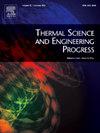EMG sensor and infrared thermal radiation image analysis in martial arts training activities: Muscle thermodynamic simulation
IF 5.1
3区 工程技术
Q2 ENERGY & FUELS
引用次数: 0
Abstract
Martial arts not only requires athletes to have superb skills and good physical fitness, but also requires them to be able to precisely control the movement of muscles. Myoelectric sensors capture the electrical signals generated during muscle activity, while infrared thermal imaging technology allows for non-invasive measurement and visualization of temperature changes on muscle surfaces. Myoelectric sensor and infrared thermal radiation image technology are used to analyze the muscle activity of martial arts athletes in the training process. Athletes are asked to perform a series of standardized martial arts movements, while using myoelectric sensors to record the electrical signals generated by muscle activity and high-precision infrared thermal imaging cameras to capture changes in muscle surface temperature during the execution of the movements. After data collection, the EMG signal and infrared thermal images were processed by signal processing and image analysis technology, and the computer simulation technology was introduced to build a muscle thermodynamic model to simulate and predict the thermodynamic behavior of muscles under different training loads. The experimental results show that athletes with different martial arts movements and different training levels have significant differences in muscle activity and thermodynamic characteristics. Through the data recorded by the myoelectric sensor, we found that some specific martial arts movements will trigger high-intensity activities of specific muscle groups, and these activities are directly related to the increase of muscle surface temperature, and the increase of muscle temperature is positively correlated with the degree of muscle fatigue after high-intensity training. Athletes with a higher level of training have a smaller increase in muscle temperature when performing the same movements, indicating that they have better muscle heat regulation.
求助全文
约1分钟内获得全文
求助全文
来源期刊

Thermal Science and Engineering Progress
Chemical Engineering-Fluid Flow and Transfer Processes
CiteScore
7.20
自引率
10.40%
发文量
327
审稿时长
41 days
期刊介绍:
Thermal Science and Engineering Progress (TSEP) publishes original, high-quality research articles that span activities ranging from fundamental scientific research and discussion of the more controversial thermodynamic theories, to developments in thermal engineering that are in many instances examples of the way scientists and engineers are addressing the challenges facing a growing population – smart cities and global warming – maximising thermodynamic efficiencies and minimising all heat losses. It is intended that these will be of current relevance and interest to industry, academia and other practitioners. It is evident that many specialised journals in thermal and, to some extent, in fluid disciplines tend to focus on topics that can be classified as fundamental in nature, or are ‘applied’ and near-market. Thermal Science and Engineering Progress will bridge the gap between these two areas, allowing authors to make an easy choice, should they or a journal editor feel that their papers are ‘out of scope’ when considering other journals. The range of topics covered by Thermal Science and Engineering Progress addresses the rapid rate of development being made in thermal transfer processes as they affect traditional fields, and important growth in the topical research areas of aerospace, thermal biological and medical systems, electronics and nano-technologies, renewable energy systems, food production (including agriculture), and the need to minimise man-made thermal impacts on climate change. Review articles on appropriate topics for TSEP are encouraged, although until TSEP is fully established, these will be limited in number. Before submitting such articles, please contact one of the Editors, or a member of the Editorial Advisory Board with an outline of your proposal and your expertise in the area of your review.
 求助内容:
求助内容: 应助结果提醒方式:
应助结果提醒方式:


